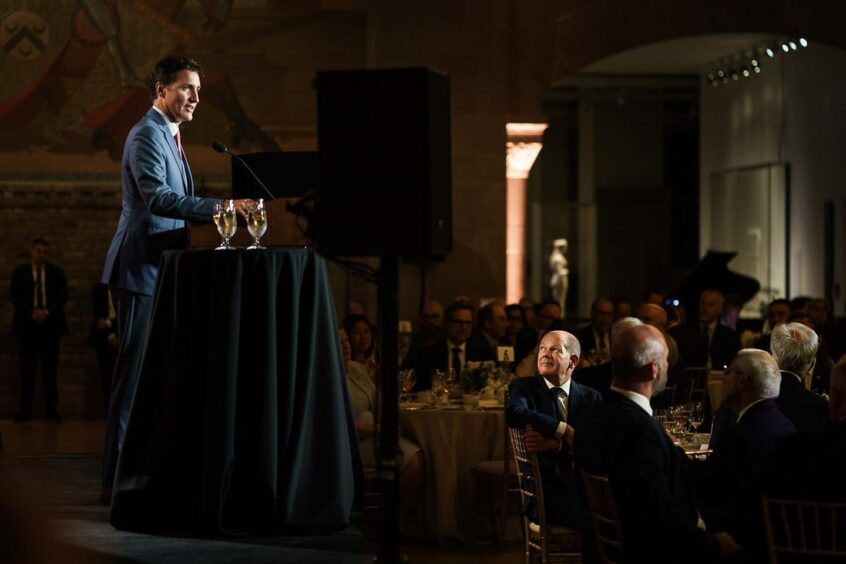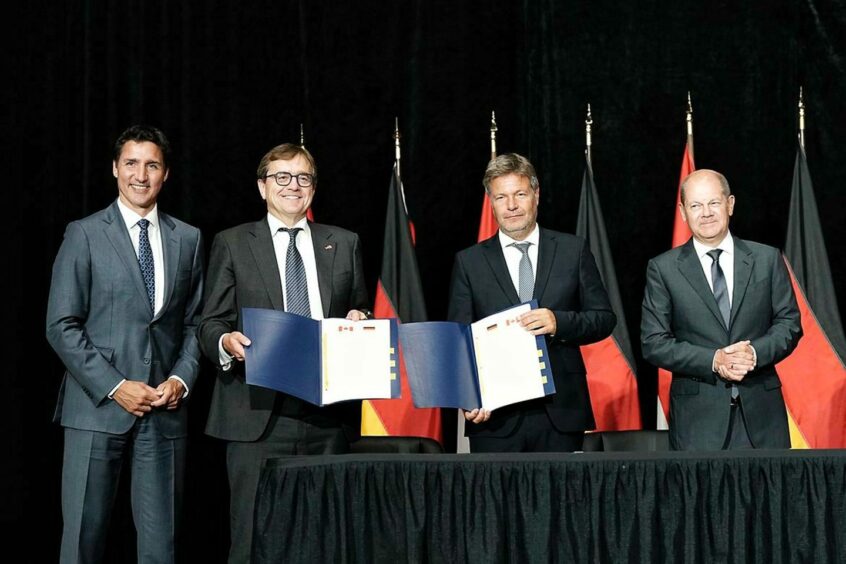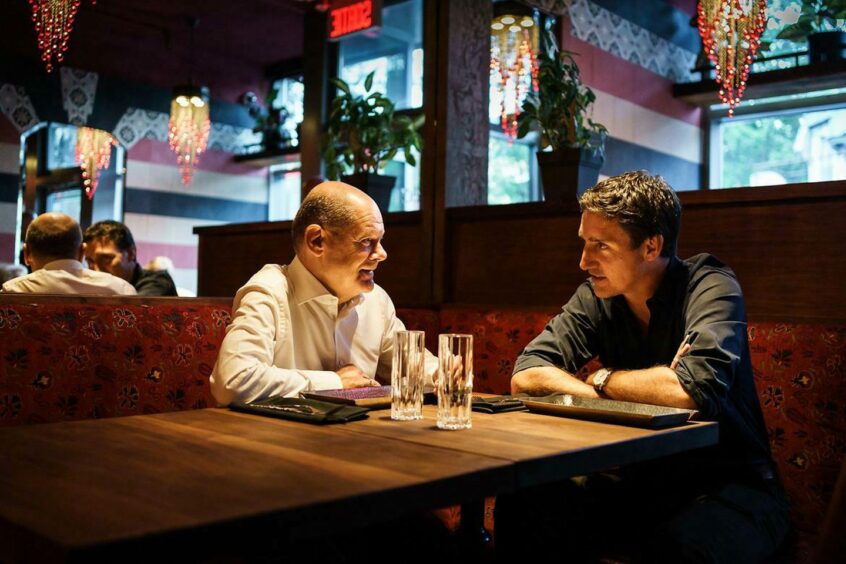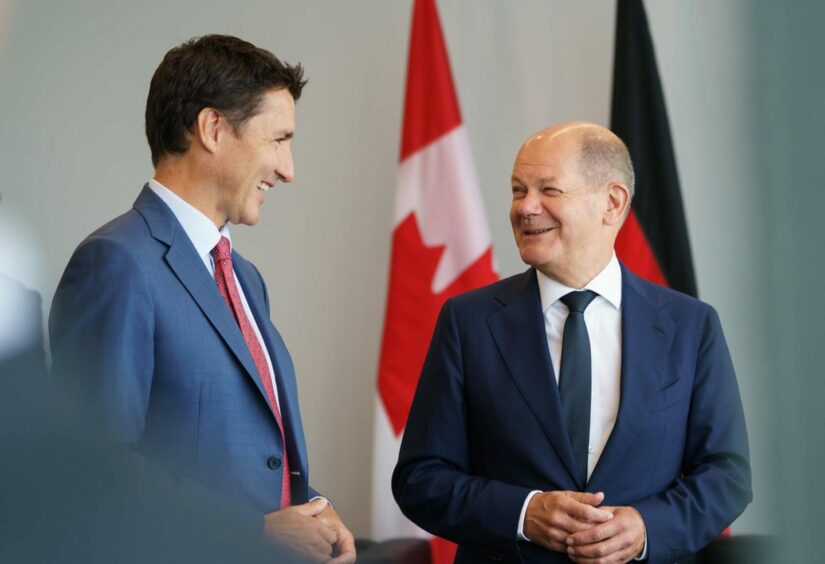
Germany has been on the hunt for new LNG supplies in order to stave off the near term crisis of stuttering Russian gas supplies. Chancellor Olaf Scholz’s visit to Canada did not come through on the LNG front, but he did seal an ambitious deal on hydrogen.
Scholz signed a number of agreements with Prime Minister Justin Trudeau. In the concluding talks, in Stephenville on August 23, the two signed a joint declaration of intent to establish the Canada-Germany Hydrogen Alliance.
The two agreed that this would back a “supply corridor”, from Canada to Germany, to deliver hydrogen exports starting in 2025.
Trudeau said Canada was committed to supporting Germany’s energy needs and its drive for climate action.
Canada signed a memorandum of understanding (MoU) with the Netherlands in 2021 on hydrogen. This also raised the possibility of a hydrogen corridor, but failed to make firm commitments on target dates.
The agreement with Germany is a much bigger deal.
“Canada has enormous potential as a reliable supplier of energy in a net-zero world. Our government is committed to working with our allies to ensure Canadian resources ensure clean energy security at home and around the world,” said Minister of Natural Resources Canada Jonathan Wilkinson.
“Governments have to show leadership,” said Fasken partner and leader of the company’s Hydrogen Energy Advisory Team Dan Brock said.
“Canada will need to marshal everything to meet this specific objective”, of supplying green hydrogen to Germany by 2025. “It will need policy development, investment, energy and attention. We need something equivalent to a wartime command and control economic planning and investment.”
Here and then
German comments on the trip and deal focused on the sense of future links.
“Throughout our visit there was a palpable sense that the future is within reach,” Scholz said on his visit. The German statement said Canada was the “partner of choice” as an alternative to Russian energy.
Federal Minister of Economic Affairs Robert Habeck, who accompanied Scholz, spoke of an “energy partnership for the future”.
However, Germany – and its government – has a difficult road in navigating its move away from Russian gas, at least in the short term.
Demand has fallen 13% in Germany, a note from Fitch Ratings. The agency expects Russian gas deliveries to Germany to fall to zero in 2023. It sees 0.6 bcm of LNG imports into Germany this year, rising to 17.3 bcm in 2023.
Assuming that winter is not dramatically cold, Germany “could weather a scenario of very low Russian gas imports”, Fitch said, without resorting to outright rationing.
While LNG offers a short term need, there is a much longer term opportunity for hydrogen, RANE’s Europe analyst Matteo Ilardo said.
“Industry doesn’t want to commit to building the export facilities or buying the LNG carriers if there is not a solid business case – and I don’t think there is,” Ilardo said. The German government’s commitment to hydrogen, on the other hand, makes investments into this area easier.
“There’s long-term prospects for hydrogen in Europe. It can be used to generate electricity but also for industry, which is where Germany uses most of its gas.”
LNG hopes
In the near term, Germany is focused on signing up new supplies of LNG – and the infrastructure required to secure these flows. This week, Germany signed up the delivery of its fifth FSRU, which should come into operation in the 2023-24 winter.
Scholz linked LNG to the effort to move away from Russia’s energy. “Canada is our partner of choice. For now, this means increasing our LNG imports. We hope that Canadian LNG will play a major role in this.”
Trudeau did not endorse LNG exports from any of the Canadian projects that have been lobbying for support. The prime minister said Canada would “do what we can” to assist LNG exports, but stopped short of providing direct intervention.
This reticence stands in contrast to Germany’s steps to secure imports. The government has been an enthusiastic participant in securing FSRUs and has also stepped in to help energy companies such as Uniper.
The difference of course is one of time scales. Germany intends to import LNG for a relatively limited amount of time, while it transitions to longer term options – such as hydrogen.
For Canada’s exporters, on the other hand, construction of liquefaction terminals rests on a much longer projection. Such plans typically require long-term offtake contracts of 15-20 years to provide builders with the surety required for the multi-billion dollar investments.
“Germany is not ready to sign long-term contracts, it clashes with other strategic priorities around climate goals. Buyers in Asia don’t have these same problems,” Ilardo said.
Canada lacks export capacity. It can scale up production, but this can only really go to the US market. This might help lower US benchmark prices and free up more gas for export at the Gulf Coast, but this feels like a roundabout solution to Germany’s needs.
Furthermore, plans such as Pieridae Energy’s Goldboro LNG continue to face environmental opposition from local groups.
Hydrogen production and exports may not face the same opposition.
Going greener
Scholz noted this double challenge, of diversification and energy transformation, in his speech in Canada. “What lies ahead is nothing less than the biggest transformation of our economy, infrastructure and mobility since the beginning of the industrial revolution,” he said.
Germany intends to be “climate neutral” by 2045, the chancellor said, while remaining a major industrialised power. The country aims to produce 80% of its electricity from renewables by 2030.
Scholz’s decision to visit Trudeau “is validation of Canada’s potential to become a powerhouse in the export of clean hydrogen”, Brock said.
Canada launched a hydrogen strategy in 2020, which the Fasken lawyer described as “short on specifics” but wide ranging.
The arrival of the German delegation has been critical in moving the discussion forward. Before Scholz’s visit, “the Canadian government’s embrace of hydrogen felt more aspirational than concrete. Now, taking the steps necessary for Canada to be able to export clean hydrogen to Germany by 2025 is a very ambitious undertaking.”
The certainty from the government gives a clear signal, Brock continued, to all participants: the federal government, provincial governments, industry, investors and the public.
RANE Europe analyst Matteo Ilardo agreed that it is important to get things started. “There’s a lack of infrastructure for LNG and a lack of infrastructure for hydrogen – but those are different problems.”
LNG would require cross-country pipelines in Canada to bring gas to export facilities, he said. Hydrogen will not need cross-country pipelines in Canada, with coastal wind turbines driving electrolysers.
Ilardo went on to say Europe was working to include carbon prices in imported goods. Under this scenario, green hydrogen is an increasingly attractive option.
Local investment
Fasken’s Brock said exports of hydrogen were “only half the story”. Making progress in this regard will also put Canada in a much stronger position to build up its domestic industry and export expertise, he said.
“Canada needs two things to happen at the same time. We need to work on very specific tasks around exporting green hydrogen: technology, supply chain, choosing ports, taking decisions on how to ship. The other thing that has to happen, though, is the fostering capacity and broader public awareness and support.
“This will happen if the government starts to make a bunch of smaller investments in the Canadian supply chain, to create an ecosystem and develop expertise.”
A number of deals were signed under the Canada-Germany hydrogen plan.
Trudeau and Scholz held talks with a number of provincial heads during the August trip. These include Premier Andrew Furey of Newfoundland and Labrador, Premier Blaine Higgs of New Brunswick, Premier Tim Houston of Nova Scotia and Premier Dennis King of Prince Edward Island. The premiers signed a statement in support of the hydrogen alliance.
Company moves
Nova Scotia’s EverWind signed preliminary offtake agreements with Uniper and E.ON for the supply of green ammonia. EverWind is developing hydrogen and ammonia projects in Nova Scotia.
The company expects to reach commercial operation at its Point Tupper project in early 2025. The initial phase carries an expected price tag of $6 billion. EverWind has also signed agreements with two First Nations corporations, from the local Mi’kmaq.
The deals with the German companies are for 500,000 tonnes per year each. Uniper had previously expressed an interest in securing LNG volumes from Goldboro LNG – but has cooled on this plan in recent times.
Another hydrogen developer, World Energy GH2, officially launched its C$12bn Project Nujio’qonik in Newfoundland and Labrador during the Scholz-Trudeau visit. This aims to begin producing in 2024.
The Stephenville plant will produce 250,000 tpy of green hydrogen. World Energy said its plan would be a “key contributor” to the German-Canadian alliance. The project will use 3 GW of onshore wind power to drive 1.5 GW of electrolysers to produce hydrogen, which it will then export in the form of green ammonia.
ABB and Canada’s Hydrogen Optimized agreed to combine their offerings in support of large-scale green hydrogen production. The deal will focus on commercialising the Canadian company’s high-power water electrolysis technology.
Recommended for you


 © Supplied by German Chancellor
© Supplied by German Chancellor © Supplied by German Chancellor
© Supplied by German Chancellor © Supplied by Canada PM
© Supplied by Canada PM